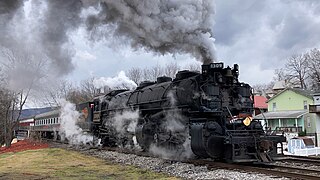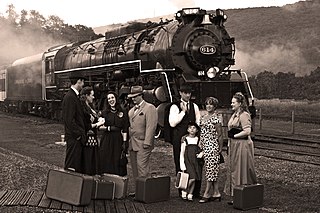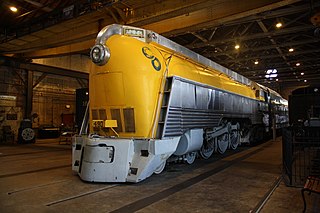
Under the Whyte notation for the classification of steam locomotives, 4-8-2 represents the wheel arrangement of four leading wheels, eight powered and coupled driving wheels and two trailing wheels. This type of steam locomotive is commonly known as the Mountain type.

The New York Central Railroad (NYC) called the 4-8-2 type of steam locomotive the Mohawk type. It was known as the Mountain type on other roads, but the New York Central did not see the name as fitting on its famous Water Level Route. Instead, it picked the name of one of those rivers its rails followed, the Mohawk River, to name its newest type of locomotive. Despite the more common name, the 4-8-2 was actually suited in many ways more to flatland running than slow mountain slogging, with its 4-wheel leading truck for stability at speed. However, the L1s and L2s were unstable at higher speeds due to the lack of effective cross-balancing, making the 4-wheel leading truck simply a better distributor of the locomotives weight; the L1s and L2s were consequently limited to 60 mph (97 km/h), though this issue was resolved for the L3s and L4s using data gathered from two experimental L-2s.

Under the Whyte notation for the classification of locomotives, 4-6-4 represents the wheel arrangement of four leading wheels, six powered and coupled driving wheels and four trailing wheels. In France where the type was first used, it is known as the Baltic while it became known as the Hudson in most of North America.
The Great Western Railway 3800 Class, also known as the County Class, were a class of 4-4-0 steam locomotives for express passenger train work introduced in 1904 in a batch of ten. Two more batches followed in 1906 and 1912 with minor differences. They were designed by George Jackson Churchward, who used standard components to produce a four-coupled version of his Saint Class 4-6-0s.

The North Eastern Railway Class S3, classified B16 by the LNER, was a class of 4-6-0 steam locomotive designed for mixed traffic work. It was designed by Vincent Raven and introduced in 1920. The earlier members of this class were fitted with Westinghouse Brakes - all of this equipment was removed during the 1930s.

Chesapeake & Ohio 614 is a class "J-3-A" 4-8-4 "Greenbrier" (Northern) type steam locomotive built in June 1948 by the Lima Locomotive Works in Lima, Ohio for the Chesapeake and Ohio Railway (C&O) as a member of the J-3-A class. As one of the last commercially built steam locomotives in the United States, the locomotive was built with the primary purpose of hauling long, heavy, high speed express passenger trains for the Chesapeake & Ohio Railway such as the George Washington and the Fast Flying Virginian. Retired from active service in the late 1950s, the 614 was preserved and placed on display at the B&O Railroad Museum in Baltimore, Maryland. Between 1979 and 1980, restoration work on the locomotive to operating condition took place and it was used for extensive mainline excursion service from the early 1980s until the late 1990s. Since 2011, the locomotive has been on display at the C&O Railway Heritage Center in Clifton Forge, Virginia.
The Chesapeake and Ohio Railway's class L-2 comprised eight coal-fired 4-6-4 "Hudson" type steam locomotives numbered 300–307 and built by the Baldwin Locomotive Works of Philadelphia, Pennsylvania in 1941. They had roller bearings on all axles, and the first-built, No. 300, also had roller bearings on its side and main rods. No. 300 bore "Elephant ear" smoke deflectors from 1948.

Reading 2101 is a preserved American class "T-1" 4-8-4 "Northern" type steam locomotive constructed in 1945 for use by the Reading Company. Constructed from an earlier "I10SA" 2-8-0 "Consolidation"-type locomotive built in 1923, the 2101 handled heavy coal train traffic for the Reading until being retired from revenue service in 1959. Withheld from scrapping, the 2101 served as emergency backup power for the three other T1 locomotives serving the Reading's "Iron Horse Rambler" excursions until being sold for scrap in 1964. In 1975, the locomotive was restored to operation from scrapyard condition in an emergency 30-day overhaul after being selected to pull the first eastern portion of the American Freedom Train. On March 6, 1979, while being stored one winter in a Chessie System roundhouse in Silver Grove, KY, 2101 was severely damaged in a fire. Also damaged in that fire was a NYC Mohawk tender, which is now located at the National New York Central Railroad Museum in Elkhart, Indiana. 2101 was cosmetically restored and placed in the B&O Railroad Museum on Labor Day, 1979, in exchange for Chesapeake and Ohio 614. Today the locomotive remains on display in its American Freedom Train #1 paint scheme.

The USRA 2-6-6-2 is a standardized design of 2-6-6-2 Mallet locomotives developed by the United States Railroad Administration during World War I.

The GCR Class 8B was a class of 27 two-cylinder steam locomotives of the 4-4-2 wheel arrangement built between 1903 and 1906 for the Great Central Railway. They were nicknamed "Jersey Lillies" after the famous music star Lillie Langtry.
Maine Central Railroad Class O locomotives were originally intended for heavy freight service. They were of 4-6-0 wheel arrangement in the Whyte notation, or "2'C" in UIC classification. They replaced earlier class P 2-6-0 locomotives beginning in 1903. They were in turn replaced by class W 2-8-0 locomotives for the heaviest freight service beginning in 1910, but remained in use on branch line trains until replaced by diesel locomotives after World War II. They proved so well-suited for branch line service the design was among the last steam locomotives built for the Maine Central.

Maine Central Railroad Class C locomotives were intended for main line passenger service. They were of 4-6-2 wheel arrangement in the Whyte notation, or " 2'C1' " in UIC classification. They replaced earlier class N 4-6-0 locomotives beginning in 1907. Class C locomotives pulled named passenger trains until replacement by diesel locomotives after World War II.

The Reading T-1 was a class of 4-8-4 "Northern" type steam locomotives owned by the Reading Company. They were rebuilt from 30 "I-10sa" class 2-8-0 "Consolidation" type locomotives between 1945 and 1947. Out of the 30 rebuilt, 4 survive in preservation today, those being numbers 2100, 2101, 2102 and 2124.

The Chesapeake and Ohio H-8 was a class of 60 2-6-6-6 steam locomotives built by the Lima Locomotive Works in Lima, Ohio between 1941 and 1948, operating until the mid 1950s. The locomotives were among the most powerful steam locomotives ever built and hauled fast, heavy freight trains for the railroad. Only two units were preserved; Nos. 1601 and 1604.

Western Maryland Scenic Railroad No. 734, also known as Mountain Thunder, is an SC-1 class 2-8-0 “Consolidation” type steam locomotive originally built by the Baldwin Locomotive Works in 1916 for the Lake Superior & Ishpeming Railroad (LS&I) as No. 18. It was renumbered to 34 in 1925.
Lake Superior and Ishpeming Railroad No. 33 is a preserved SC-1 class 2-8-0 "consolidation" type steam locomotive originally built by the Baldwin Locomotive Works in April 1916 for the Munising, Marquette and Southeastern Railway as No. 44. In 1924, the MM&SE was purchased by the Lake Superior and Ishpeming Railroad and the locomotive was renumbered to 33. It served the LS&I by pulling heavy iron ore trains until it was retired from revenue service in 1962. The following year, it was sold to the Marquette and Huron Mountain tourist railroad to operate in excursion service, but instead sat idle in Marquette. In 1965, No. 33 was purchased by the founders of the Hocking Valley Scenic Railway in Ohio. Rebuilt to operating condition, No. 33 ran on the HVSR for many years before being sidelined in 1996 for an FRA-required overhaul that couldn't be accomplished. In 2003, No. 33 was traded to the Ohio Central Railroad and was overhauled for some occasional excursion runs between 2005 and 2008. The locomotive briefly operated again around the Age of Steam Roundhouse between 2018 and 2020. As of 2023, No. 33 is sidelined, awaiting to go through a 1,472-day inspection.

The Louisville and Nashville M-1 was a class of forty-two 2-8-4 steam locomotives built during and after World War II as dual-service locomotives. They were nicknamed "Big Emmas" by crews and were built in three batches between 1942 and 1949.

The Chesapeake and Ohio Greenbrier was a class of 12 4-8-4 "Greenbrier" type steam locomotives built by the Lima Locomotive Works between 1935 and 1948 and operated by the C&O. Like a handful of railroads, the C&O didn't name their 4-8-4s "Northerns", and instead went with the name "Greenbrier" after the Greenbrier Hotel in White Sulphur Springs, West Virginia, a major resort on the C&O mainline.
Baltimore and Ohio No. 5300, also known as President Washington, is the sole survivor of the P-7 class 4-6-2 "Pacific" type steam locomotives. It was built by Baldwin in 1927, and it was used on mainline passenger trains across the Baltimore and Ohio system, particularly the Royal Blue train, until it was retired in 1957. After being stored for a few years, it was donated to the Baltimore and Ohio Railroad Museum in Baltimore, Maryland, where it has spent several years on static display. The locomotive is undergoing a cosmetic restoration, as of 2023.

Chesapeake and Ohio No. 490 is the sole survivor of the L-1 class 4-6-4 "Hudson" type steam locomotives. It was built by Alco's Richmond works in 1926 as an F-19 class 4-6-2 "Pacific" type to be used to pull the Chesapeake and Ohio's secondary passenger trains. It was eventually rebuilt in 1947 to become a streamlined 4-6-4 for the C&O's Chessie streamliner. After the Chessie was cancelled, No. 490 remained in secondary passenger service, until it was retired in 1953. It spent several years in storage in Huntington, West Virginia, until 1968, when it was donated to the B&O Railroad Museum in Baltimore, Maryland. It remains on static display at the museum, as of 2023.














